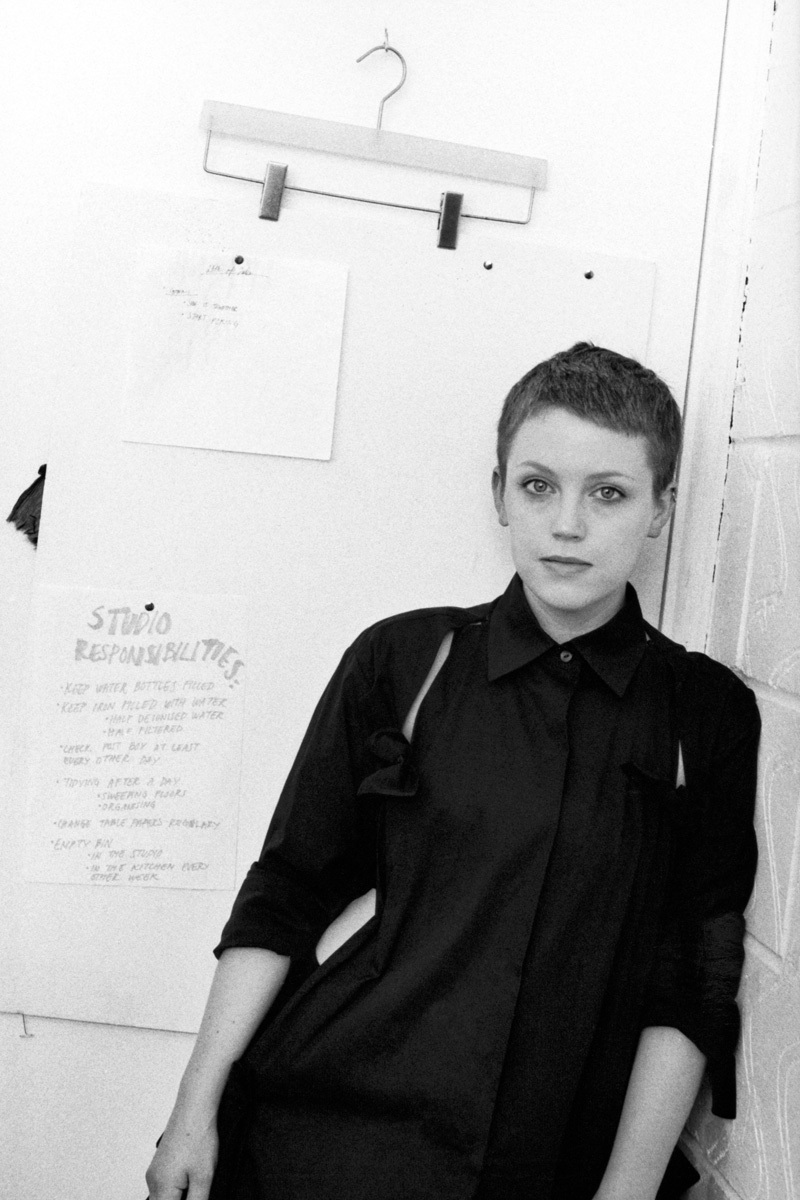Undulated rocks become the pleats of a frayed dress. A black and white Kertész picture transforms into a sharp A-line skirt. The bark of an old tree decides the volume of a classic shirt. Welcome to the mind of RCA graduate Katie Roberts-Wood, where a single shell or flower petal can inspire an entire collection.
Katie works with a small team of four people (and one dog) in a tiny but brightly-lit studio next to Regent’s Canal in Haggerston, East London. She just finished shipping her second collection, is about to start designing her third, and things are kicking off. Where the first collection was sold in Dover Street Market only, she now has 11 additional retailers around the world. She has even hired a full time business partner: “I really would recommend every emerging designer to get a business partner, because it’s really hard when you’re on your own. When you come from fashion school, you’re kinda blind to that side of things.”
Katie is learning about the practical sides of starting up your own label, and realises how much it influences her everyday creative process. Thinking about how people would buy and wear her clothes changed the way she designed. “It makes it more challenging to design, but I find it quite fascinating.” Her collections have definitely evolved since her MA, and now offer more wearable and accessible pieces. “I want to purify the work without watering it down.” Cotton shirts and dresses now feature alongside her signature explosions of volume and texture, but she’s careful not to become too commercial: “I don’t want to lose that creative freedom where you are allowed to make something impractical. For my brand specifically, it’s quite important to retain both of those elements.” For her latest collection, she experimented with soft and fluid fabrics – a very different look from the structural leather cocoons in her graduate collection. “We use a lot of sheer, but I hope what is shown is considered. The element of femininity should be strong, not vulnerable.” Though she still works with big volumes and sharp lines, a subtle delicacy now accompanies each silhouette.
Looking at her extravagant pieces, it is hard to imagine that this girl studied to become a doctor before applying for an MA in Fashion at the RCA. You can find some hints of her past in the inspiration for her collections – the organic and mineral shapes, the microscopic patterns of botanical structures – but Katie has left her med-student life far behind her. “I hardly ever remember that’s what I did,” she admits. “Through med school I was constantly making things, and I continued doing this until I realised it was that big of a thing that I couldn’t not be doing it every day.” It took five years of medicine to find her true passion, though by the time she realised what she really wanted, quitting her studies to work in the creative industry didn’t feel like a difficult decision.
Initially self-taught, Katie instinctively looked for new ways to design, rejecting traditional techniques. For her graduate collection, she researched how she could mend her clothes without using a sewing machine; her innovative designs were held together with holes, loops and knots.
Katie is still fascinated by construction – the process that transforms a flat piece of fabric into a three-dimensional sculpture – and is continuously looking for ways to reinvent it. Her SS16 collection included a skirt composed of multiple tiny L-shaped leather figures that clicked together. The last collection featured a dress that was entirely knotted. What makes this way of working even more interesting is that the wearer is free to play with the design: untie a few knots and the back of a dress can be replaced by a sheer equivalent, while the sleeves of a shirt can be removed entirely.
Katie has a relentless thirst for innovative techniques. Though the volumes and intricate constructions are impressive at first sight, the true beauty of Katie’s garments isn’t revealed until you physically touch them – it is then that the hours of manual labour and experimentation become apparent. “Some of the pieces might seem like I’ve just sewn a bunch of fabric to a dress, but on the inside you can see how intense the construction is.” Katie can spend a week single-handedly fraying the edges of a dress, or cutting out the hundred miniscule parts that form a skirt. Between her hands, the designer holds the dearest of all luxuries: time.
Unfortunately, the fashion industry isn’t built to accommodate this rhythm. Starting her own label also meant stepping into the fashion calendar, which has a worryingly tight schedule. “There’s definitely a challenge to keep up with someone else’s timeline. I can’t afford to spend a year on a single dress anymore. I often wonder how we’ll be able to maintain this level of work as we grow.” The answer is timelessness; some pieces might take weeks to manufacture, but they’ll be worn for a lifetime. Katie doesn’t do trends: “Trends are something I never really understood, I never got my head around it. It never seemed important to me in the design process. Of course everything is influenced by the moment you’re making it in, but I certainly don’t look at trends for inspiration.”
Thinking of the many things she’s already achieved, Katie repeatedly asks herself the same question: how can I get better? A true perfectionist, she’s rarely satisfied with her work. “Looking back on my work, there is always something I want to change. Because I’m constantly learning, I feel like I’m constantly coming up with ways to make it better.” We can be assured that, for Katie, things will only get better.
Read: Per Gotesson reflects on the world in his work.
Credits
Text Aya Noël
Photography James Robjant
